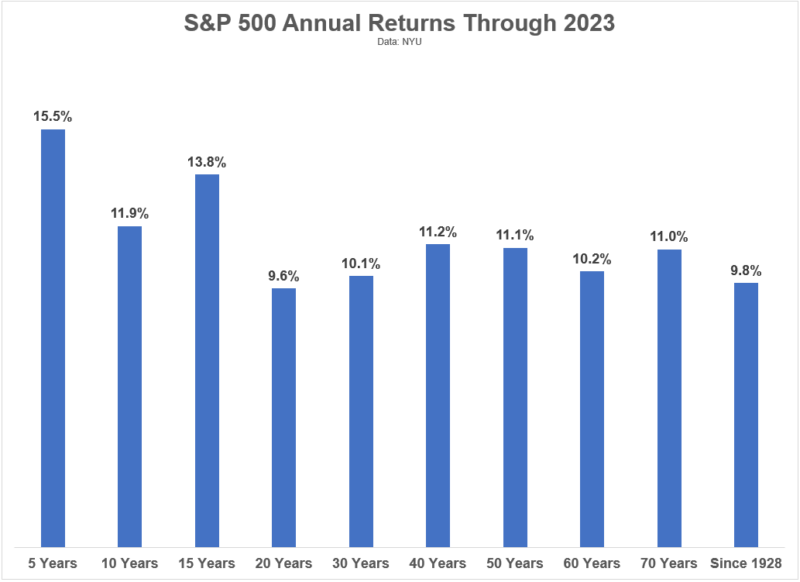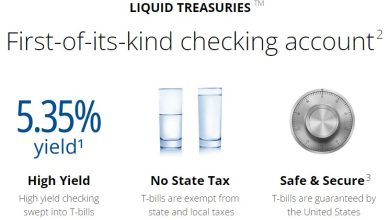The Rule of 10

Compounding is one of the hardest concepts to understand.
Human beings are not good at visualizing it because it’s extremely difficult to visualize logarithmic growth. A penny doubling every day for 30 days becomes more than $5.3 million. That seems impossible.
This is one reason why so few people invest their money in the stock market.
We think it’s gambling because it’s impossible to predict where the market will go in the short term. We also fail to recognize that the market goes up and the right in the long term. Both can be, and are, true.
This chart from Ben Carlson’s A Wealth of Common Sense blog highlights this beautifully:

We are essentially the house in a game of blackjack. The odds are in our favor so we are more likely to win the longer we play the game. Time in the market trumps all else.
To convince ourselves to make the right decision, we have to simplify it. We have to make it an easy to understand tradeoff.
If you invest $100 today and it compounds at 8% a year for 30 years, it’ll be worth $1,006.27.
That’s the Rule of 10.
$100 invested today will be $1000 in thirty years.
We can debate the growth rate or perhaps the time period, but if you accept them at face value, then you’ll have $1,000.62 for every $100 you invest today.
Wait Jim, $1,000 doesn’t seem like a lot!
If the rule of 10 seems a little underwhelming… that’s because it is. Turning $100 into $1,000 would be great if it happened overnight. Or even within a year or two. If it takes 30 years, it sounds less exciting right?
But after another 10 years, the amount will double to $2,072.45.
And if you keep contributing, as you would in an investment portfolio, the portfolio will continue to grow at these accelerated paces. You aren’t saving $100 once. You’re going to have to do it over and over again.
This rule can help you understand tradeoffs between what you spend today and what you invest. It’s easier to conceptualize that you can spend $100 on another jacket today or spend an $1,000 in retirement.
No difficult calculations to remember, just multiple by ten.
But the power in investing isn’t in making one contribution and then stopping, right? What if you contribute $100 a month for 30 years and it compounds at 8% annually? You end up with $149,035.94 on $36,000 in contributions.
If you take it out to 40 years, the total is now $349,100.78 (on $48,000 of contributions).
That’s with just $100 a month.
Are you skeptical about the 8% rate or want a different time frame?
Here’s a simple table of how much $100 is worth after compounding for a certain number of years – make your own rule!
| Rate of Return | Years of Growth | Final Value |
|---|---|---|
| 10% | 30 | $1,744.94 |
| 10% | 20 | $672.75 |
| 10% | 10 | $259.37 |
| 8% | 30 | $1,006.27 |
| 8% | 20 | $466.10 |
| 8% | 10 | $215.89 |
| 6% | 30 | $574.35 |
| 6% | 20 | $320.71 |
| 6% | 10 | $179.08 |
You can use this investment calculator to do your own math and come up with your own rule. I use 8% and 30 years because it results in a nice number – 10X.
Whenever you’re deciding on a purchase, ask yourself… do you want it today or do you want 10 times that in retirement?
Sometimes it’ll be the purchase. Sometimes I’d rather keep the money and invest it.
Either way, now you’re making an accurate trade off.
Other Posts You May Enjoy:
70+ Wedding Ideas on a Budget
The average cost of a wedding in 2023 was $29,000, and if you live in an expensive city like New York, LA, or DC, you can expect to pay even more. But it doesn’t have to be that way. To save money on your special day, check out our list of 70 wedding ideas on a budget. Learn more.
Don’t Fall Victim to Mimetic Desire
Mimetic desire is a theory that your desires are influenced by the people around you. Conceptualized by a 20th-century French philosopher, mimetic desire is present in almost everything we do. Learn how to leverage it for good and resist it when it’s bad.
MaxMyInterest Review: Is It Worth It?
MaxMyInterest is a fintech app that connects to several online banks to find you the highest savings APYs.
Each month, Max provides you with the optimal mix of balances to help you earn the best rates. But is MaxMyInterest worth the cost, and how does it compare to platforms like Raisin? Learn more in this MaxMyInterest review.
Don’t Chase Investing Trends: How Media Attention Impacts Your Investments
Trends in investing come and go but your retirement nest egg has to grow for decades. Learn how trends start, how to avoid them, and what you should do if you feel the itch to jump on the bandwagon.

About Jim Wang
Jim Wang is a forty-something father of four who is a frequent contributor to Forbes and Vanguard’s Blog. He has also been fortunate to have appeared in the New York Times, Baltimore Sun, Entrepreneur, and Marketplace Money.
Jim has a B.S. in Computer Science and Economics from Carnegie Mellon University, an M.S. in Information Technology – Software Engineering from Carnegie Mellon University, as well as a Masters in Business Administration from Johns Hopkins University. His approach to personal finance is that of an engineer, breaking down complex subjects into bite-sized easily understood concepts that you can use in your daily life.
One of his favorite tools (here’s my treasure chest of tools,, everything I use) is Personal Capital, which enables him to manage his finances in just 15-minutes each month. They also offer financial planning, such as a Retirement Planning Tool that can tell you if you’re on track to retire when you want. It’s free.
He is also diversifying his investment portfolio by adding a little bit of real estate. But not rental homes, because he doesn’t want a second job, it’s diversified small investments in a few commercial properties and farms in Illinois, Louisiana, and California through AcreTrader.
Recently, he’s invested in a few pieces of art on Masterworks too.
Opinions expressed here are the author’s alone, not those of any bank or financial institution. This content has not been reviewed, approved or otherwise endorsed by any of these entities.
Reader Interactions




